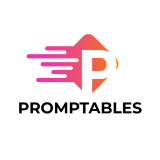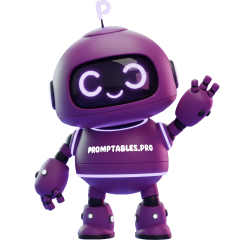
Promptables CANVAS: Complete Guide & Analysis
🎨 What is Promptables CANVAS?
Promptables CANVAS is a specialized design-focused GPT that transforms SPARK prompts into comprehensive design guidelines for AI coding platforms. It acts as a bridge between your structured app requirements and the detailed visual specifications needed by AI coders like Lovable.dev, Bolt.new, Replit, Cursor, and Vercel v0.
Core Purpose: Convert SPARK-generated prompts into professional design documentation that includes UI/UX specifications, color schemes, typography, component layouts, and interaction patterns.
Key Features
- Senior Design Expertise: Draws from 30+ years of experience with top-tier brands
- Comprehensive Design Documentation: Creates detailed markdown guides with 9 structured sections
- Mobile-First Approach: Prioritizes responsive design and accessibility
- Component-Based Structure: Breaks down UI into manageable, coded components
- Performance & Security Focus: Includes technical considerations for production apps
📊 Tool Analysis
Strengths
- Comprehensive Coverage: 9 detailed sections covering every design aspect
- Professional Quality: Senior-level design expertise and industry best practices
- Consistent Structure: Standardized markdown format perfect for AI coders
- Technical Integration: Includes performance, security, and accessibility considerations
- AI Coder Optimized: Output format specifically designed for coding platforms
Limitations
- Fixed Template: Locked into specific 9-section structure
- No Visual Output: Text-only guidelines without actual mockups or wireframes
- Generic Components: May not capture unique design requirements
- Dependency on SPARK: Works best with well-structured SPARK prompts
🔄 CANVAS Workflow Integration
Optimal Workflow: SPARK → CANVAS → AI Coder
1SPARK Phase: Generate structured app requirements and technical specifications
2CANVAS Phase: Transform SPARK output into detailed design guidelines
3AI Coder Phase: Use combined SPARK + CANVAS output for development
Pro Tip: Combine both SPARK and CANVAS outputs when prompting AI coding platforms for the most comprehensive results.
💡 Best Practices for Using CANVAS
Before You Start
- Have a completed SPARK prompt ready as your foundation
- Identify any specific design preferences or brand guidelines
- Consider your target audience's design expectations
- Think about unique visual elements that differentiate your app
- Prepare any reference websites or design inspiration
Crafting Your CANVAS Prompt
- Include SPARK Output: Paste your complete SPARK prompt as context
- Specify Design Preferences: Mention colors, fonts, or style preferences
- Reference Inspiration: Include URLs or descriptions of design inspiration
- Clarify Platform: Specify if mobile-first, web-first, or specific platform needs
- Mention Constraints: Any technical or accessibility requirements
⚠️ Potential Pitfalls & How to Avoid Them
Common Issues
- Generic Design Output: CANVAS might produce template-like designs without unique character
- Over-Specification: Too much detail can overwhelm AI coding platforms
- Brand Misalignment: Generated designs might not match existing brand guidelines
- Technical Feasibility: Suggested animations or interactions might be complex to implement
Prevention Strategies
- Provide Brand Context: Include existing brand colors, fonts, and style guidelines
- Specify Uniqueness: Ask for distinctive elements that set your app apart
- Validate Feasibility: Review technical recommendations with your development constraints
- Customize Output: Edit the generated guidelines to match your specific needs
💰 Credit Optimization Strategies
Maximize Efficiency
- Complete SPARK First: Have your functional requirements fully defined
- Single Comprehensive Prompt: Include all design preferences in one request
- Reference Materials Ready: Have inspiration links and brand assets prepared
- Batch Similar Projects: Process related apps together for consistency
When to Use CANVAS vs. Manual Design
| Project Type | Recommendation | Reason |
|---|---|---|
| Complex multi-page app | Use CANVAS | Comprehensive guidelines worth the investment |
| Simple landing page | Consider manual | May be overkill for basic layouts |
| First-time design project | Use CANVAS | Educational value and professional structure |
| Existing brand guidelines | Hybrid approach | Use CANVAS then customize for brand |
✍️ Writing Better Prompts for CANVAS
Template for Optimal CANVAS Prompt
Here's my SPARK prompt for [APP NAME]:
[PASTE COMPLETE SPARK OUTPUT]
Additional design requirements:
- Primary brand color: [HEX CODE]
- Design inspiration: [REFERENCE WEBSITES/APPS]
- Target audience: [DEMOGRAPHIC DETAILS]
- Unique elements: [DISTINCTIVE FEATURES YOU WANT]
- Platform priority: [MOBILE-FIRST/WEB-FIRST/BOTH]
- Accessibility needs: [ANY SPECIFIC REQUIREMENTS]
Please create comprehensive design guidelines that emphasize [KEY DESIGN GOALS].🔄 Integration with AI Coding Platforms
| Platform | CANVAS Compatibility | Best Use Case | Notes |
|---|---|---|---|
| Lovable.dev | Excellent | Full design implementation | Handles detailed design specs perfectly |
| Bolt.new | Very Good | Rapid UI prototyping | Focus on component sections |
| Vercel v0 | Excellent | Component-based development | Perfect for UI component generation |
| Cursor | Good | Custom implementation | Use as reference during development |
| Replit | Good | Educational projects | Great for learning design patterns |
🎓 Client Onboarding Checklist
Before Using CANVAS
- Complete your SPARK prompt first
- Gather brand assets (logos, colors, fonts)
- Collect design inspiration and references
- Define your target audience demographics
- Identify unique design requirements
- Consider accessibility and performance needs
- Determine platform priorities (mobile vs web)
- Set realistic design complexity expectations
After Getting CANVAS Output
- Review all 9 sections for completeness
- Validate color schemes and typography choices
- Check component layouts for feasibility
- Confirm mobile responsiveness approach
- Verify accessibility compliance
- Test design concepts with target users
- Customize guidelines for your brand
- Prepare combined SPARK+CANVAS prompt for AI coder
📋 CANVAS Output Structure
The 9 Essential Sections CANVAS Provides:
- General Design Overview - App purpose, tone, and design personality
- Color Scheme - Complete palette with HEX codes and usage guidelines
- Typography - Font families, weights, sizes, and hierarchy
- UI Components - Detailed layouts for all major app sections
- Mobile UX & Accessibility - Responsive design and accessibility considerations
- Icons & Visual Style - Icon sets, imagery, and visual guidelines
- Microinteractions & Animations - Interaction patterns and animation specs
- Performance Considerations - Technical optimization recommendations
- Security & Privacy Design - User-facing security and privacy elements
🎯 Key Recommendations
Top 5 Success Factors for CANVAS
- Start with SPARK - Always have functional requirements defined first
- Provide design context - Include brand guidelines and inspiration
- Customize the output - Edit generated guidelines to match your vision
- Test with AI coders - Validate the guidelines work with your chosen platform
- Iterate and refine - Use CANVAS output as a starting point, not final word
Overall CANVAS Effectiveness Rating:
- Best for: Complex apps, design-focused projects, teams without senior designers
- Limitations: Fixed template structure, no visual mockups, requires customization
- ROI: 70-90% time savings compared to creating design guidelines from scratch
